Patient Experience: Preventing Falls and Health Records Essay
VerifiedAdded on 2023/06/03
|8
|2356
|463
Essay
AI Summary
This essay analyzes patient experiences within the healthcare system, particularly focusing on the prevention of falls, the use of health records, and the impact of nursing care. The essay uses a case study of a 75-year-old patient, Mr. Taylor, who has experienced both positive and negative interactions with public and private healthcare facilities. It explores the patient's feelings, thoughts, values, and beliefs regarding the care he received, highlighting the importance of patient-centered care, communication, and timely access to information. The analysis examines the consequences of falls on the patient's physical and psychological well-being, the impact of negative experiences on trust in healthcare, and the benefits of positive patient experiences. The essay concludes with an action plan emphasizing the need to improve service quality, communication, and fall prevention strategies to enhance patient satisfaction and outcomes. The essay draws upon relevant literature to support its arguments and recommendations for improved healthcare practices.
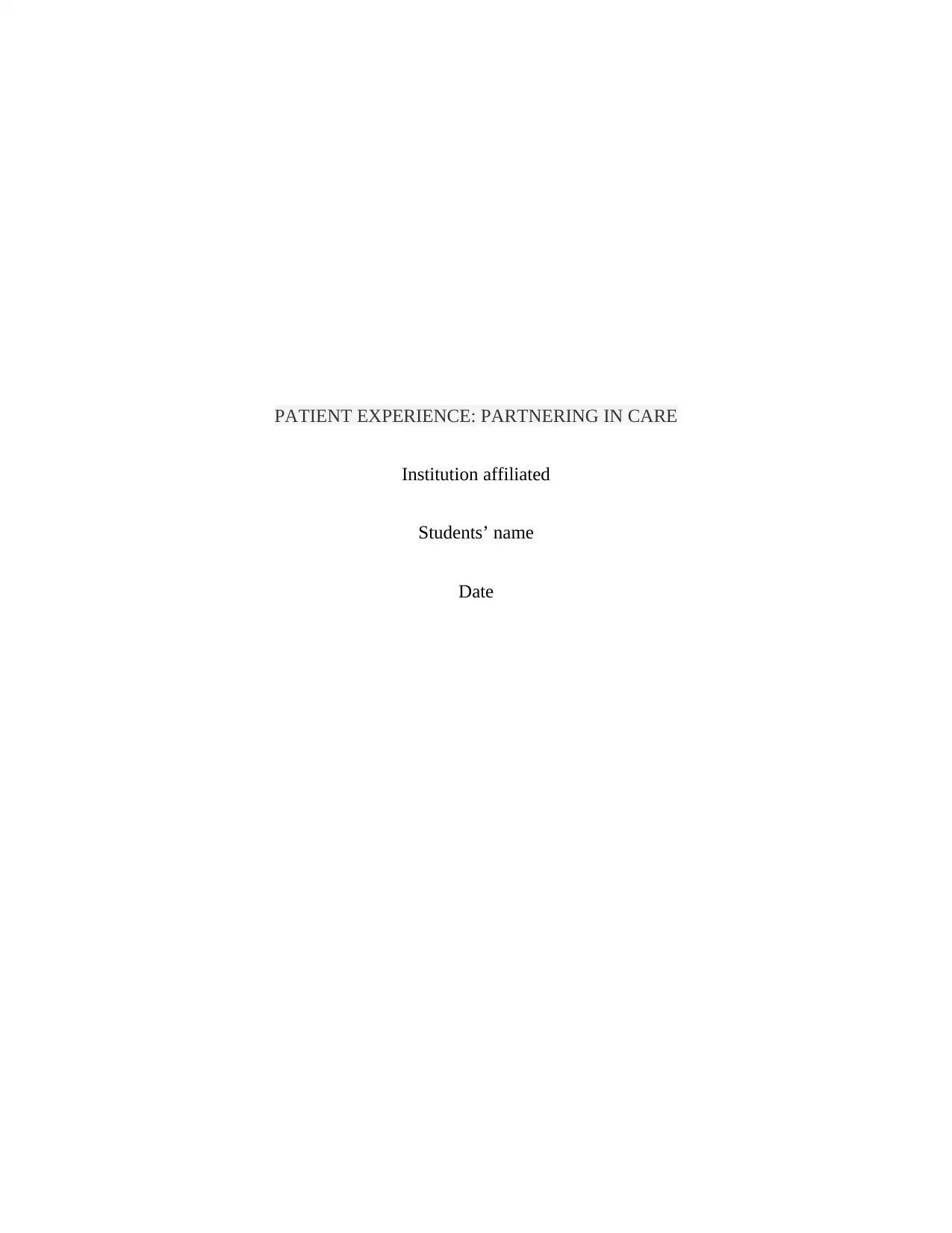
PATIENT EXPERIENCE: PARTNERING IN CARE
Institution affiliated
Students’ name
Date
Institution affiliated
Students’ name
Date
Paraphrase This Document
Need a fresh take? Get an instant paraphrase of this document with our AI Paraphraser
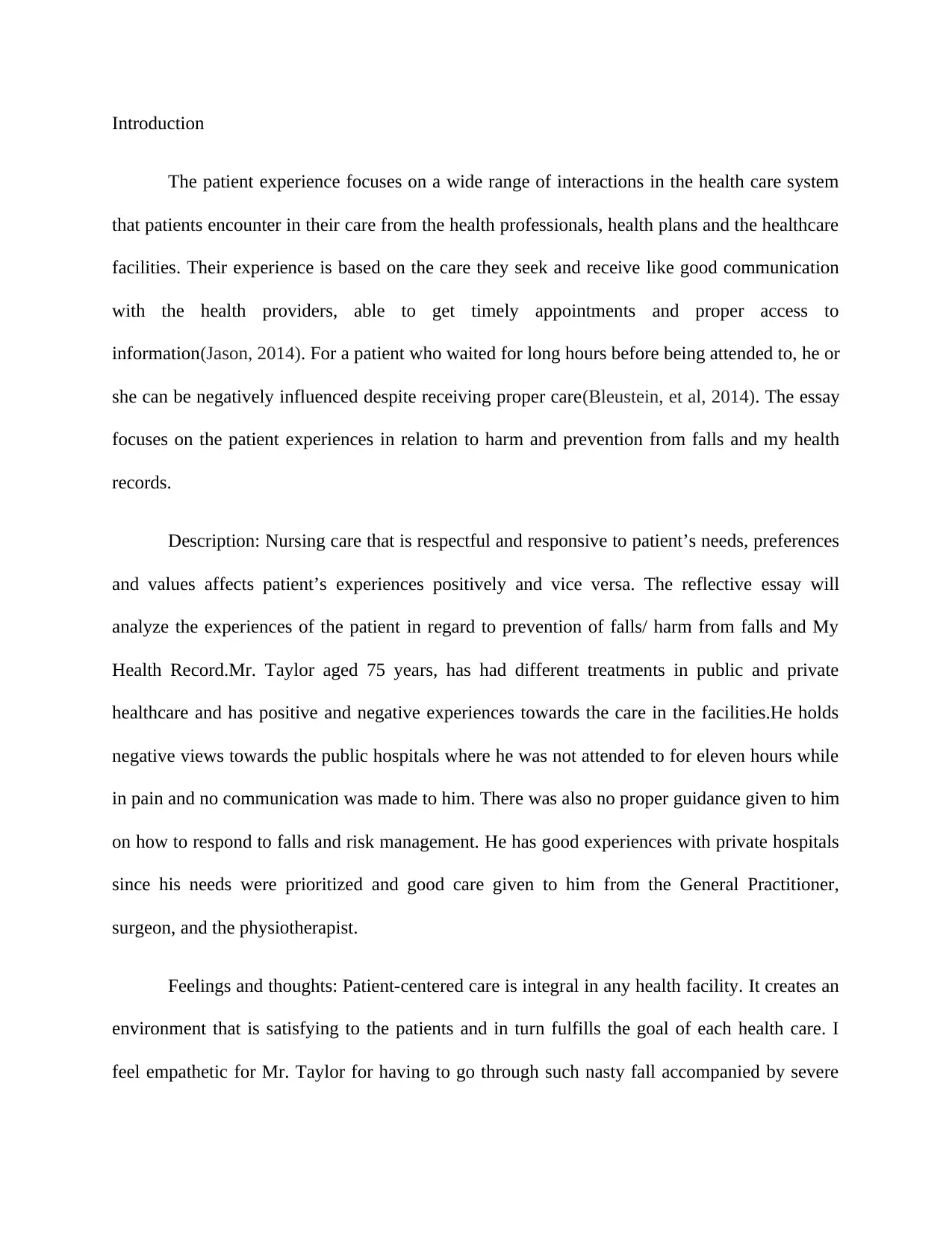
Introduction
The patient experience focuses on a wide range of interactions in the health care system
that patients encounter in their care from the health professionals, health plans and the healthcare
facilities. Their experience is based on the care they seek and receive like good communication
with the health providers, able to get timely appointments and proper access to
information(Jason, 2014). For a patient who waited for long hours before being attended to, he or
she can be negatively influenced despite receiving proper care(Bleustein, et al, 2014). The essay
focuses on the patient experiences in relation to harm and prevention from falls and my health
records.
Description: Nursing care that is respectful and responsive to patient’s needs, preferences
and values affects patient’s experiences positively and vice versa. The reflective essay will
analyze the experiences of the patient in regard to prevention of falls/ harm from falls and My
Health Record.Mr. Taylor aged 75 years, has had different treatments in public and private
healthcare and has positive and negative experiences towards the care in the facilities.He holds
negative views towards the public hospitals where he was not attended to for eleven hours while
in pain and no communication was made to him. There was also no proper guidance given to him
on how to respond to falls and risk management. He has good experiences with private hospitals
since his needs were prioritized and good care given to him from the General Practitioner,
surgeon, and the physiotherapist.
Feelings and thoughts: Patient-centered care is integral in any health facility. It creates an
environment that is satisfying to the patients and in turn fulfills the goal of each health care. I
feel empathetic for Mr. Taylor for having to go through such nasty fall accompanied by severe
The patient experience focuses on a wide range of interactions in the health care system
that patients encounter in their care from the health professionals, health plans and the healthcare
facilities. Their experience is based on the care they seek and receive like good communication
with the health providers, able to get timely appointments and proper access to
information(Jason, 2014). For a patient who waited for long hours before being attended to, he or
she can be negatively influenced despite receiving proper care(Bleustein, et al, 2014). The essay
focuses on the patient experiences in relation to harm and prevention from falls and my health
records.
Description: Nursing care that is respectful and responsive to patient’s needs, preferences
and values affects patient’s experiences positively and vice versa. The reflective essay will
analyze the experiences of the patient in regard to prevention of falls/ harm from falls and My
Health Record.Mr. Taylor aged 75 years, has had different treatments in public and private
healthcare and has positive and negative experiences towards the care in the facilities.He holds
negative views towards the public hospitals where he was not attended to for eleven hours while
in pain and no communication was made to him. There was also no proper guidance given to him
on how to respond to falls and risk management. He has good experiences with private hospitals
since his needs were prioritized and good care given to him from the General Practitioner,
surgeon, and the physiotherapist.
Feelings and thoughts: Patient-centered care is integral in any health facility. It creates an
environment that is satisfying to the patients and in turn fulfills the goal of each health care. I
feel empathetic for Mr. Taylor for having to go through such nasty fall accompanied by severe
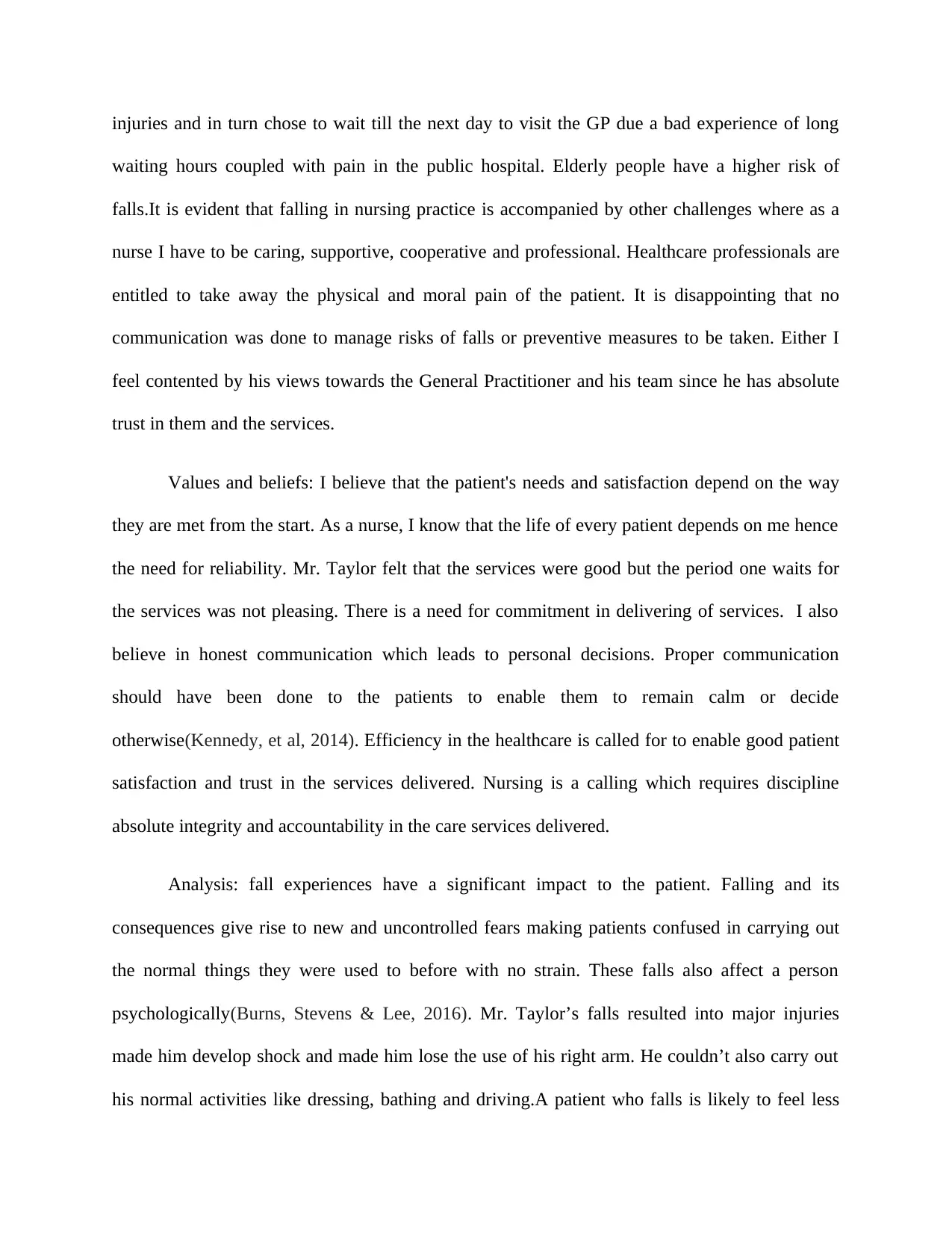
injuries and in turn chose to wait till the next day to visit the GP due a bad experience of long
waiting hours coupled with pain in the public hospital. Elderly people have a higher risk of
falls.It is evident that falling in nursing practice is accompanied by other challenges where as a
nurse I have to be caring, supportive, cooperative and professional. Healthcare professionals are
entitled to take away the physical and moral pain of the patient. It is disappointing that no
communication was done to manage risks of falls or preventive measures to be taken. Either I
feel contented by his views towards the General Practitioner and his team since he has absolute
trust in them and the services.
Values and beliefs: I believe that the patient's needs and satisfaction depend on the way
they are met from the start. As a nurse, I know that the life of every patient depends on me hence
the need for reliability. Mr. Taylor felt that the services were good but the period one waits for
the services was not pleasing. There is a need for commitment in delivering of services. I also
believe in honest communication which leads to personal decisions. Proper communication
should have been done to the patients to enable them to remain calm or decide
otherwise(Kennedy, et al, 2014). Efficiency in the healthcare is called for to enable good patient
satisfaction and trust in the services delivered. Nursing is a calling which requires discipline
absolute integrity and accountability in the care services delivered.
Analysis: fall experiences have a significant impact to the patient. Falling and its
consequences give rise to new and uncontrolled fears making patients confused in carrying out
the normal things they were used to before with no strain. These falls also affect a person
psychologically(Burns, Stevens & Lee, 2016). Mr. Taylor’s falls resulted into major injuries
made him develop shock and made him lose the use of his right arm. He couldn’t also carry out
his normal activities like dressing, bathing and driving.A patient who falls is likely to feel less
waiting hours coupled with pain in the public hospital. Elderly people have a higher risk of
falls.It is evident that falling in nursing practice is accompanied by other challenges where as a
nurse I have to be caring, supportive, cooperative and professional. Healthcare professionals are
entitled to take away the physical and moral pain of the patient. It is disappointing that no
communication was done to manage risks of falls or preventive measures to be taken. Either I
feel contented by his views towards the General Practitioner and his team since he has absolute
trust in them and the services.
Values and beliefs: I believe that the patient's needs and satisfaction depend on the way
they are met from the start. As a nurse, I know that the life of every patient depends on me hence
the need for reliability. Mr. Taylor felt that the services were good but the period one waits for
the services was not pleasing. There is a need for commitment in delivering of services. I also
believe in honest communication which leads to personal decisions. Proper communication
should have been done to the patients to enable them to remain calm or decide
otherwise(Kennedy, et al, 2014). Efficiency in the healthcare is called for to enable good patient
satisfaction and trust in the services delivered. Nursing is a calling which requires discipline
absolute integrity and accountability in the care services delivered.
Analysis: fall experiences have a significant impact to the patient. Falling and its
consequences give rise to new and uncontrolled fears making patients confused in carrying out
the normal things they were used to before with no strain. These falls also affect a person
psychologically(Burns, Stevens & Lee, 2016). Mr. Taylor’s falls resulted into major injuries
made him develop shock and made him lose the use of his right arm. He couldn’t also carry out
his normal activities like dressing, bathing and driving.A patient who falls is likely to feel less
⊘ This is a preview!⊘
Do you want full access?
Subscribe today to unlock all pages.

Trusted by 1+ million students worldwide
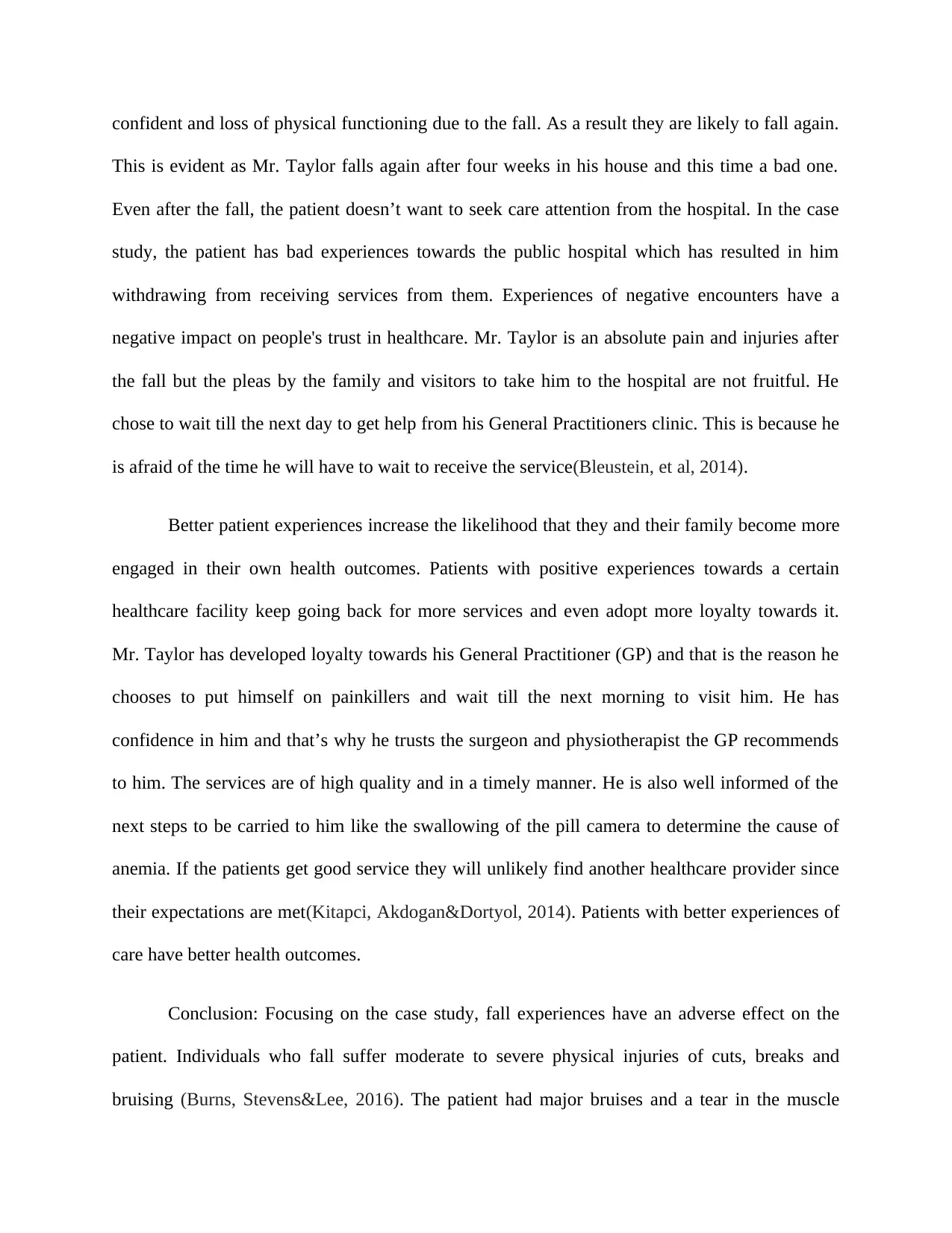
confident and loss of physical functioning due to the fall. As a result they are likely to fall again.
This is evident as Mr. Taylor falls again after four weeks in his house and this time a bad one.
Even after the fall, the patient doesn’t want to seek care attention from the hospital. In the case
study, the patient has bad experiences towards the public hospital which has resulted in him
withdrawing from receiving services from them. Experiences of negative encounters have a
negative impact on people's trust in healthcare. Mr. Taylor is an absolute pain and injuries after
the fall but the pleas by the family and visitors to take him to the hospital are not fruitful. He
chose to wait till the next day to get help from his General Practitioners clinic. This is because he
is afraid of the time he will have to wait to receive the service(Bleustein, et al, 2014).
Better patient experiences increase the likelihood that they and their family become more
engaged in their own health outcomes. Patients with positive experiences towards a certain
healthcare facility keep going back for more services and even adopt more loyalty towards it.
Mr. Taylor has developed loyalty towards his General Practitioner (GP) and that is the reason he
chooses to put himself on painkillers and wait till the next morning to visit him. He has
confidence in him and that’s why he trusts the surgeon and physiotherapist the GP recommends
to him. The services are of high quality and in a timely manner. He is also well informed of the
next steps to be carried to him like the swallowing of the pill camera to determine the cause of
anemia. If the patients get good service they will unlikely find another healthcare provider since
their expectations are met(Kitapci, Akdogan&Dortyol, 2014). Patients with better experiences of
care have better health outcomes.
Conclusion: Focusing on the case study, fall experiences have an adverse effect on the
patient. Individuals who fall suffer moderate to severe physical injuries of cuts, breaks and
bruising (Burns, Stevens&Lee, 2016). The patient had major bruises and a tear in the muscle
This is evident as Mr. Taylor falls again after four weeks in his house and this time a bad one.
Even after the fall, the patient doesn’t want to seek care attention from the hospital. In the case
study, the patient has bad experiences towards the public hospital which has resulted in him
withdrawing from receiving services from them. Experiences of negative encounters have a
negative impact on people's trust in healthcare. Mr. Taylor is an absolute pain and injuries after
the fall but the pleas by the family and visitors to take him to the hospital are not fruitful. He
chose to wait till the next day to get help from his General Practitioners clinic. This is because he
is afraid of the time he will have to wait to receive the service(Bleustein, et al, 2014).
Better patient experiences increase the likelihood that they and their family become more
engaged in their own health outcomes. Patients with positive experiences towards a certain
healthcare facility keep going back for more services and even adopt more loyalty towards it.
Mr. Taylor has developed loyalty towards his General Practitioner (GP) and that is the reason he
chooses to put himself on painkillers and wait till the next morning to visit him. He has
confidence in him and that’s why he trusts the surgeon and physiotherapist the GP recommends
to him. The services are of high quality and in a timely manner. He is also well informed of the
next steps to be carried to him like the swallowing of the pill camera to determine the cause of
anemia. If the patients get good service they will unlikely find another healthcare provider since
their expectations are met(Kitapci, Akdogan&Dortyol, 2014). Patients with better experiences of
care have better health outcomes.
Conclusion: Focusing on the case study, fall experiences have an adverse effect on the
patient. Individuals who fall suffer moderate to severe physical injuries of cuts, breaks and
bruising (Burns, Stevens&Lee, 2016). The patient had major bruises and a tear in the muscle
Paraphrase This Document
Need a fresh take? Get an instant paraphrase of this document with our AI Paraphraser
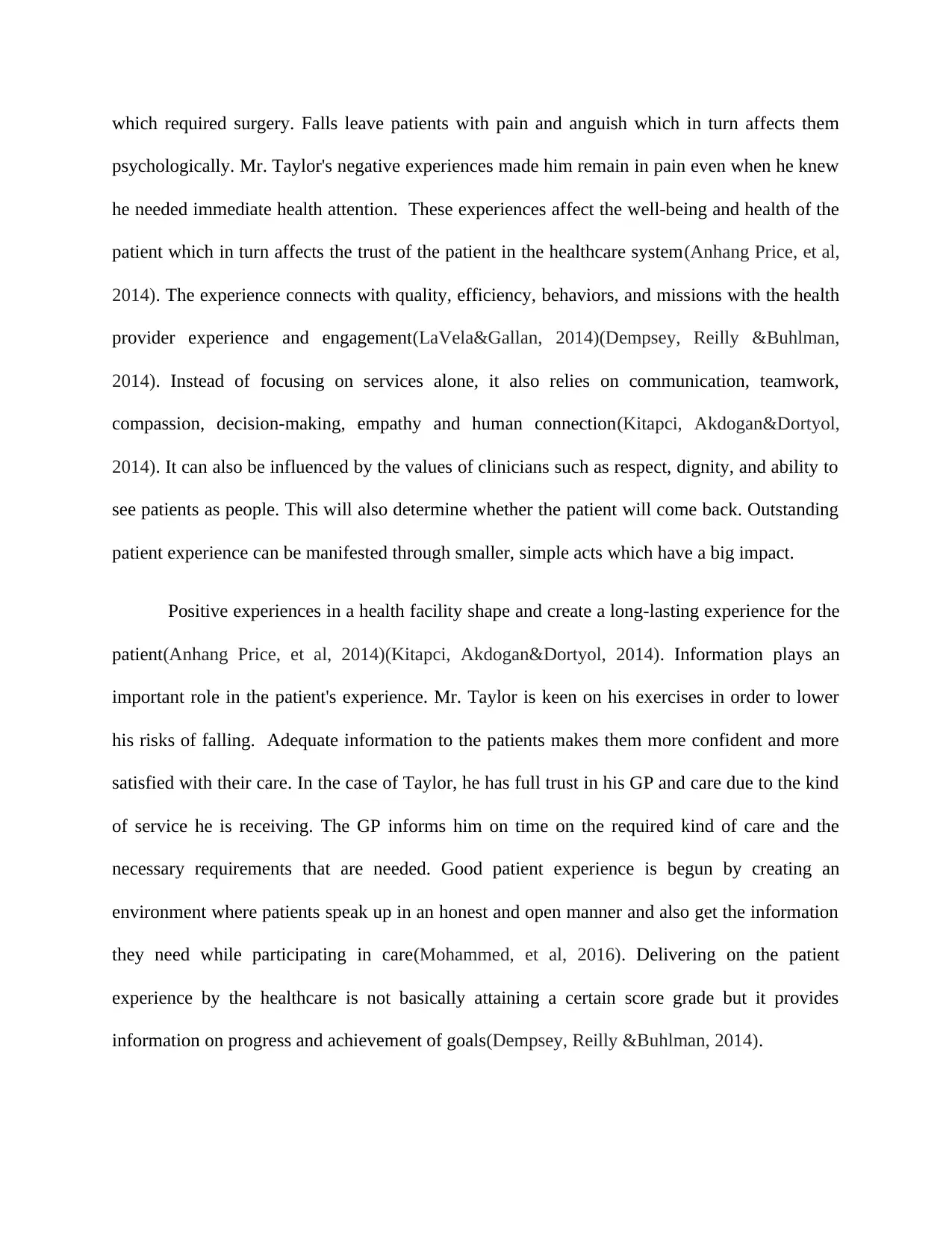
which required surgery. Falls leave patients with pain and anguish which in turn affects them
psychologically. Mr. Taylor's negative experiences made him remain in pain even when he knew
he needed immediate health attention. These experiences affect the well-being and health of the
patient which in turn affects the trust of the patient in the healthcare system(Anhang Price, et al,
2014). The experience connects with quality, efficiency, behaviors, and missions with the health
provider experience and engagement(LaVela&Gallan, 2014)(Dempsey, Reilly &Buhlman,
2014). Instead of focusing on services alone, it also relies on communication, teamwork,
compassion, decision-making, empathy and human connection(Kitapci, Akdogan&Dortyol,
2014). It can also be influenced by the values of clinicians such as respect, dignity, and ability to
see patients as people. This will also determine whether the patient will come back. Outstanding
patient experience can be manifested through smaller, simple acts which have a big impact.
Positive experiences in a health facility shape and create a long-lasting experience for the
patient(Anhang Price, et al, 2014)(Kitapci, Akdogan&Dortyol, 2014). Information plays an
important role in the patient's experience. Mr. Taylor is keen on his exercises in order to lower
his risks of falling. Adequate information to the patients makes them more confident and more
satisfied with their care. In the case of Taylor, he has full trust in his GP and care due to the kind
of service he is receiving. The GP informs him on time on the required kind of care and the
necessary requirements that are needed. Good patient experience is begun by creating an
environment where patients speak up in an honest and open manner and also get the information
they need while participating in care(Mohammed, et al, 2016). Delivering on the patient
experience by the healthcare is not basically attaining a certain score grade but it provides
information on progress and achievement of goals(Dempsey, Reilly &Buhlman, 2014).
psychologically. Mr. Taylor's negative experiences made him remain in pain even when he knew
he needed immediate health attention. These experiences affect the well-being and health of the
patient which in turn affects the trust of the patient in the healthcare system(Anhang Price, et al,
2014). The experience connects with quality, efficiency, behaviors, and missions with the health
provider experience and engagement(LaVela&Gallan, 2014)(Dempsey, Reilly &Buhlman,
2014). Instead of focusing on services alone, it also relies on communication, teamwork,
compassion, decision-making, empathy and human connection(Kitapci, Akdogan&Dortyol,
2014). It can also be influenced by the values of clinicians such as respect, dignity, and ability to
see patients as people. This will also determine whether the patient will come back. Outstanding
patient experience can be manifested through smaller, simple acts which have a big impact.
Positive experiences in a health facility shape and create a long-lasting experience for the
patient(Anhang Price, et al, 2014)(Kitapci, Akdogan&Dortyol, 2014). Information plays an
important role in the patient's experience. Mr. Taylor is keen on his exercises in order to lower
his risks of falling. Adequate information to the patients makes them more confident and more
satisfied with their care. In the case of Taylor, he has full trust in his GP and care due to the kind
of service he is receiving. The GP informs him on time on the required kind of care and the
necessary requirements that are needed. Good patient experience is begun by creating an
environment where patients speak up in an honest and open manner and also get the information
they need while participating in care(Mohammed, et al, 2016). Delivering on the patient
experience by the healthcare is not basically attaining a certain score grade but it provides
information on progress and achievement of goals(Dempsey, Reilly &Buhlman, 2014).
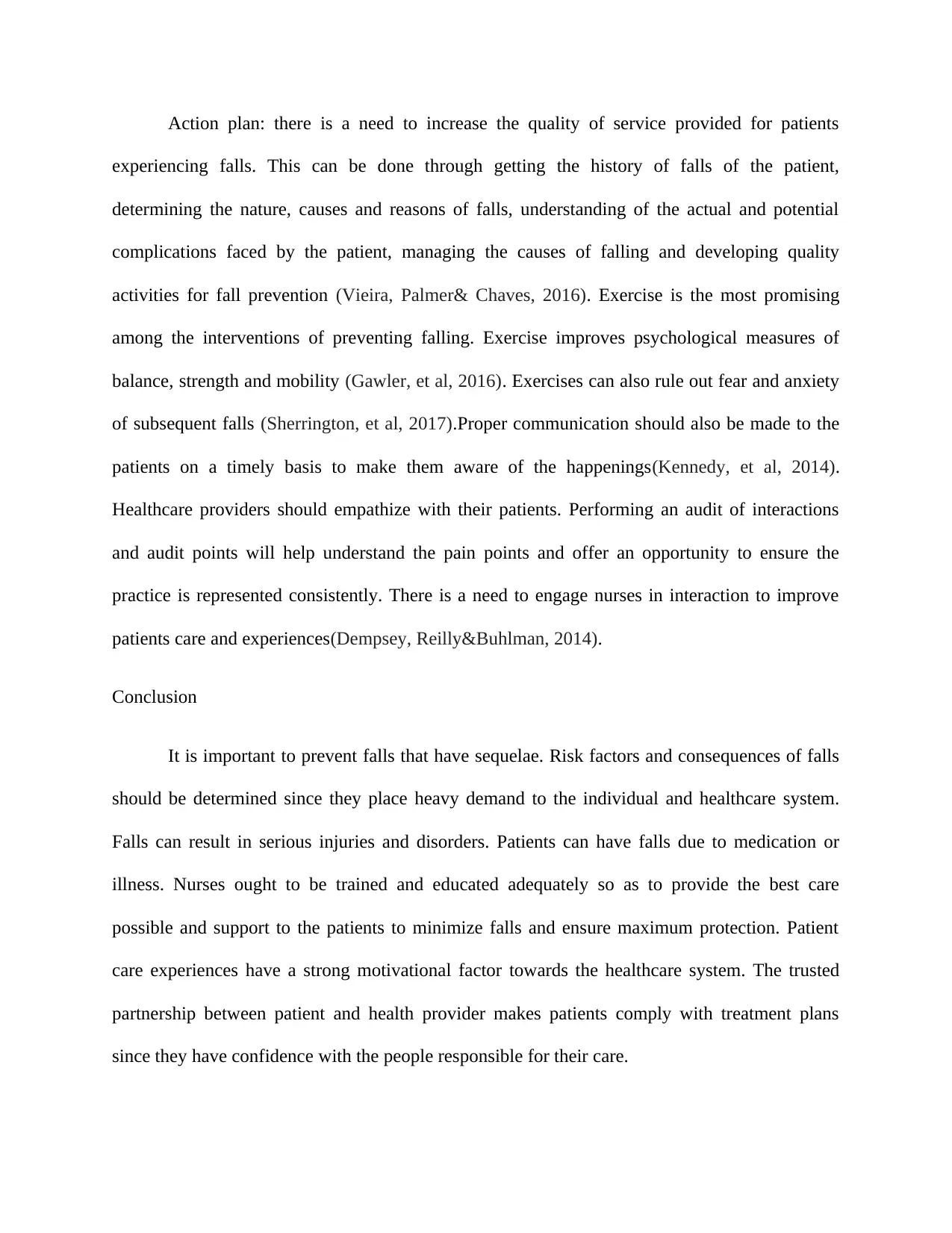
Action plan: there is a need to increase the quality of service provided for patients
experiencing falls. This can be done through getting the history of falls of the patient,
determining the nature, causes and reasons of falls, understanding of the actual and potential
complications faced by the patient, managing the causes of falling and developing quality
activities for fall prevention (Vieira, Palmer& Chaves, 2016). Exercise is the most promising
among the interventions of preventing falling. Exercise improves psychological measures of
balance, strength and mobility (Gawler, et al, 2016). Exercises can also rule out fear and anxiety
of subsequent falls (Sherrington, et al, 2017).Proper communication should also be made to the
patients on a timely basis to make them aware of the happenings(Kennedy, et al, 2014).
Healthcare providers should empathize with their patients. Performing an audit of interactions
and audit points will help understand the pain points and offer an opportunity to ensure the
practice is represented consistently. There is a need to engage nurses in interaction to improve
patients care and experiences(Dempsey, Reilly&Buhlman, 2014).
Conclusion
It is important to prevent falls that have sequelae. Risk factors and consequences of falls
should be determined since they place heavy demand to the individual and healthcare system.
Falls can result in serious injuries and disorders. Patients can have falls due to medication or
illness. Nurses ought to be trained and educated adequately so as to provide the best care
possible and support to the patients to minimize falls and ensure maximum protection. Patient
care experiences have a strong motivational factor towards the healthcare system. The trusted
partnership between patient and health provider makes patients comply with treatment plans
since they have confidence with the people responsible for their care.
experiencing falls. This can be done through getting the history of falls of the patient,
determining the nature, causes and reasons of falls, understanding of the actual and potential
complications faced by the patient, managing the causes of falling and developing quality
activities for fall prevention (Vieira, Palmer& Chaves, 2016). Exercise is the most promising
among the interventions of preventing falling. Exercise improves psychological measures of
balance, strength and mobility (Gawler, et al, 2016). Exercises can also rule out fear and anxiety
of subsequent falls (Sherrington, et al, 2017).Proper communication should also be made to the
patients on a timely basis to make them aware of the happenings(Kennedy, et al, 2014).
Healthcare providers should empathize with their patients. Performing an audit of interactions
and audit points will help understand the pain points and offer an opportunity to ensure the
practice is represented consistently. There is a need to engage nurses in interaction to improve
patients care and experiences(Dempsey, Reilly&Buhlman, 2014).
Conclusion
It is important to prevent falls that have sequelae. Risk factors and consequences of falls
should be determined since they place heavy demand to the individual and healthcare system.
Falls can result in serious injuries and disorders. Patients can have falls due to medication or
illness. Nurses ought to be trained and educated adequately so as to provide the best care
possible and support to the patients to minimize falls and ensure maximum protection. Patient
care experiences have a strong motivational factor towards the healthcare system. The trusted
partnership between patient and health provider makes patients comply with treatment plans
since they have confidence with the people responsible for their care.
⊘ This is a preview!⊘
Do you want full access?
Subscribe today to unlock all pages.

Trusted by 1+ million students worldwide
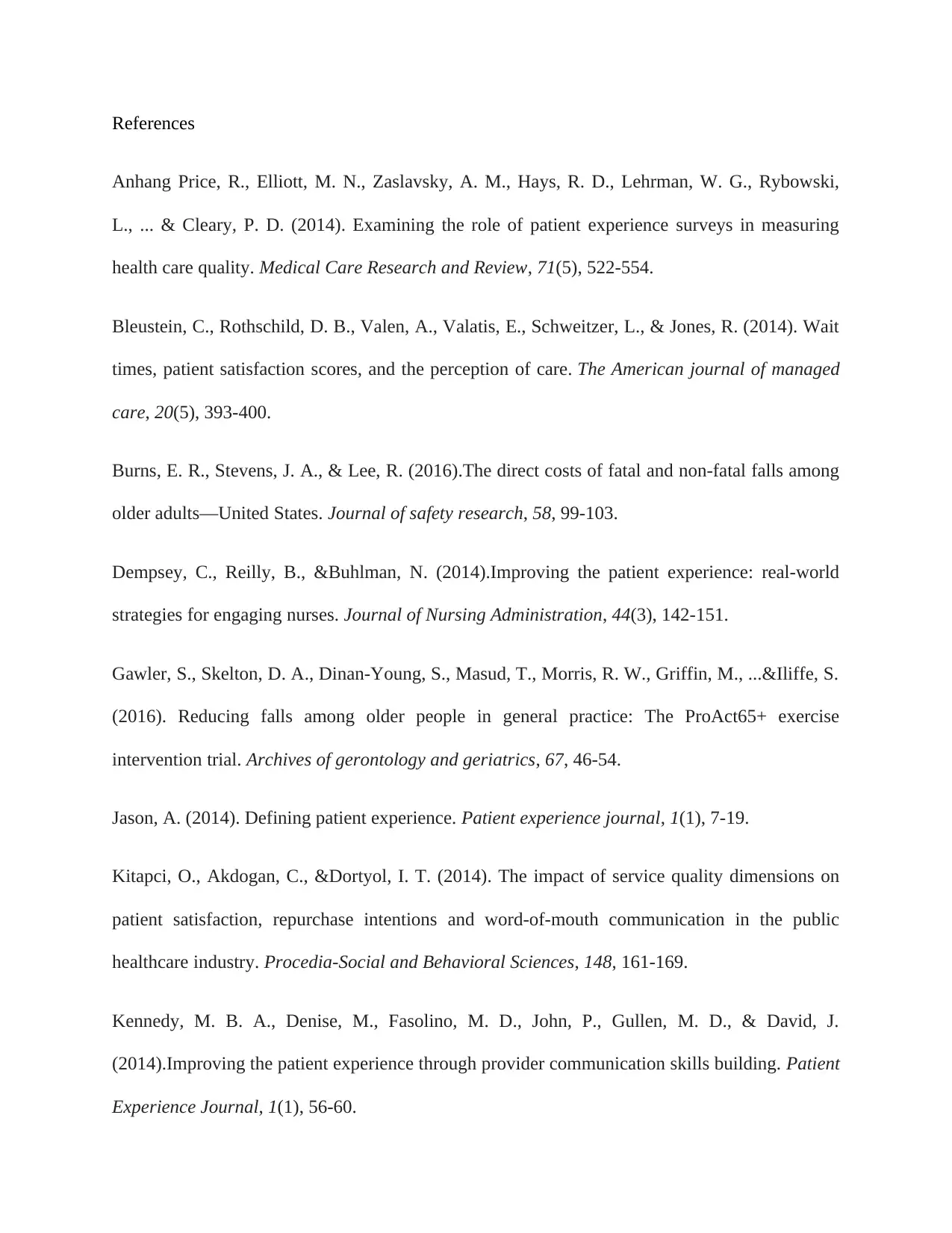
References
Anhang Price, R., Elliott, M. N., Zaslavsky, A. M., Hays, R. D., Lehrman, W. G., Rybowski,
L., ... & Cleary, P. D. (2014). Examining the role of patient experience surveys in measuring
health care quality. Medical Care Research and Review, 71(5), 522-554.
Bleustein, C., Rothschild, D. B., Valen, A., Valatis, E., Schweitzer, L., & Jones, R. (2014). Wait
times, patient satisfaction scores, and the perception of care. The American journal of managed
care, 20(5), 393-400.
Burns, E. R., Stevens, J. A., & Lee, R. (2016).The direct costs of fatal and non-fatal falls among
older adults—United States. Journal of safety research, 58, 99-103.
Dempsey, C., Reilly, B., &Buhlman, N. (2014).Improving the patient experience: real-world
strategies for engaging nurses. Journal of Nursing Administration, 44(3), 142-151.
Gawler, S., Skelton, D. A., Dinan-Young, S., Masud, T., Morris, R. W., Griffin, M., ...&Iliffe, S.
(2016). Reducing falls among older people in general practice: The ProAct65+ exercise
intervention trial. Archives of gerontology and geriatrics, 67, 46-54.
Jason, A. (2014). Defining patient experience. Patient experience journal, 1(1), 7-19.
Kitapci, O., Akdogan, C., &Dortyol, I. T. (2014). The impact of service quality dimensions on
patient satisfaction, repurchase intentions and word-of-mouth communication in the public
healthcare industry. Procedia-Social and Behavioral Sciences, 148, 161-169.
Kennedy, M. B. A., Denise, M., Fasolino, M. D., John, P., Gullen, M. D., & David, J.
(2014).Improving the patient experience through provider communication skills building. Patient
Experience Journal, 1(1), 56-60.
Anhang Price, R., Elliott, M. N., Zaslavsky, A. M., Hays, R. D., Lehrman, W. G., Rybowski,
L., ... & Cleary, P. D. (2014). Examining the role of patient experience surveys in measuring
health care quality. Medical Care Research and Review, 71(5), 522-554.
Bleustein, C., Rothschild, D. B., Valen, A., Valatis, E., Schweitzer, L., & Jones, R. (2014). Wait
times, patient satisfaction scores, and the perception of care. The American journal of managed
care, 20(5), 393-400.
Burns, E. R., Stevens, J. A., & Lee, R. (2016).The direct costs of fatal and non-fatal falls among
older adults—United States. Journal of safety research, 58, 99-103.
Dempsey, C., Reilly, B., &Buhlman, N. (2014).Improving the patient experience: real-world
strategies for engaging nurses. Journal of Nursing Administration, 44(3), 142-151.
Gawler, S., Skelton, D. A., Dinan-Young, S., Masud, T., Morris, R. W., Griffin, M., ...&Iliffe, S.
(2016). Reducing falls among older people in general practice: The ProAct65+ exercise
intervention trial. Archives of gerontology and geriatrics, 67, 46-54.
Jason, A. (2014). Defining patient experience. Patient experience journal, 1(1), 7-19.
Kitapci, O., Akdogan, C., &Dortyol, I. T. (2014). The impact of service quality dimensions on
patient satisfaction, repurchase intentions and word-of-mouth communication in the public
healthcare industry. Procedia-Social and Behavioral Sciences, 148, 161-169.
Kennedy, M. B. A., Denise, M., Fasolino, M. D., John, P., Gullen, M. D., & David, J.
(2014).Improving the patient experience through provider communication skills building. Patient
Experience Journal, 1(1), 56-60.
Paraphrase This Document
Need a fresh take? Get an instant paraphrase of this document with our AI Paraphraser
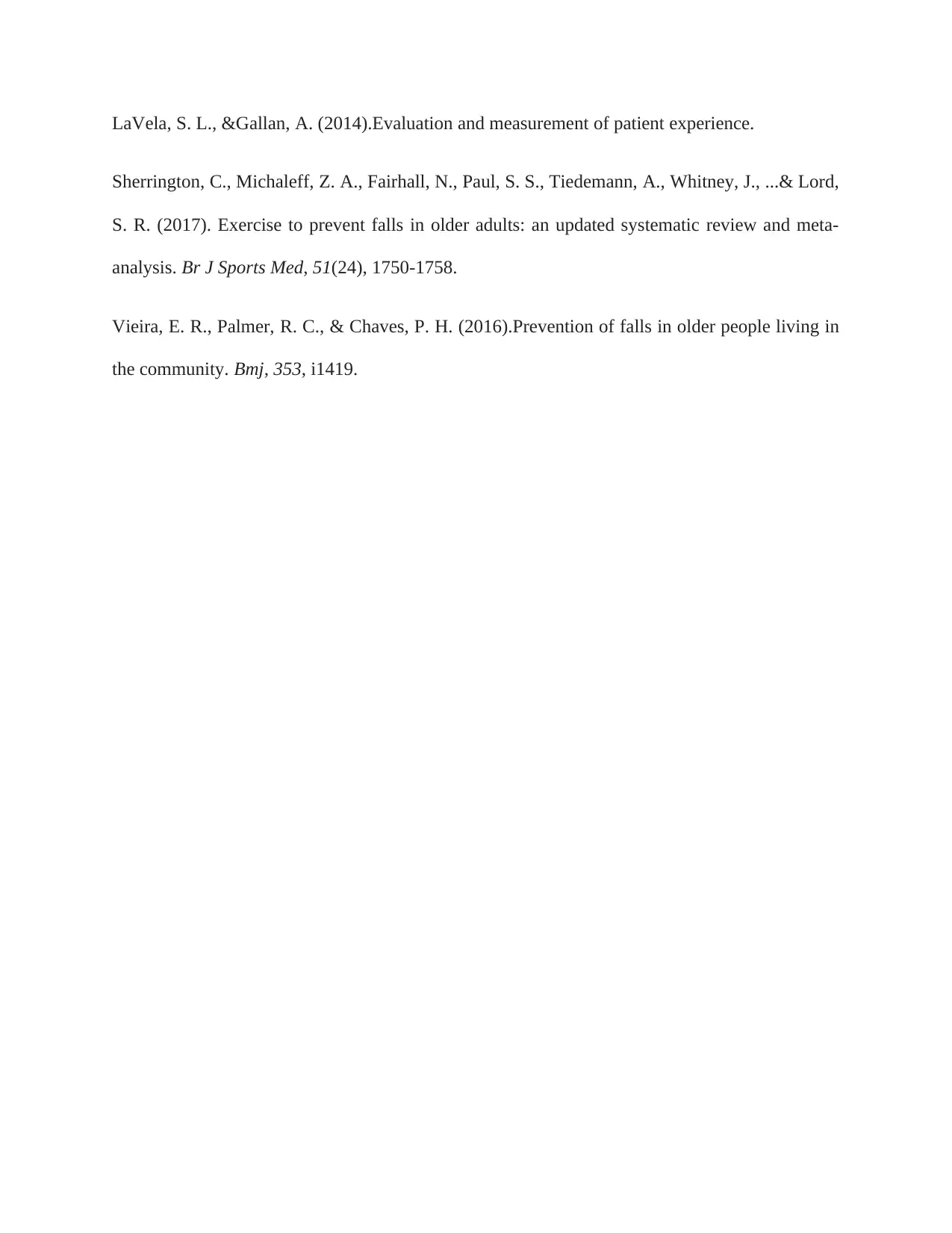
LaVela, S. L., &Gallan, A. (2014).Evaluation and measurement of patient experience.
Sherrington, C., Michaleff, Z. A., Fairhall, N., Paul, S. S., Tiedemann, A., Whitney, J., ...& Lord,
S. R. (2017). Exercise to prevent falls in older adults: an updated systematic review and meta-
analysis. Br J Sports Med, 51(24), 1750-1758.
Vieira, E. R., Palmer, R. C., & Chaves, P. H. (2016).Prevention of falls in older people living in
the community. Bmj, 353, i1419.
Sherrington, C., Michaleff, Z. A., Fairhall, N., Paul, S. S., Tiedemann, A., Whitney, J., ...& Lord,
S. R. (2017). Exercise to prevent falls in older adults: an updated systematic review and meta-
analysis. Br J Sports Med, 51(24), 1750-1758.
Vieira, E. R., Palmer, R. C., & Chaves, P. H. (2016).Prevention of falls in older people living in
the community. Bmj, 353, i1419.
1 out of 8
Related Documents
Your All-in-One AI-Powered Toolkit for Academic Success.
+13062052269
info@desklib.com
Available 24*7 on WhatsApp / Email
![[object Object]](/_next/static/media/star-bottom.7253800d.svg)
Unlock your academic potential
Copyright © 2020–2025 A2Z Services. All Rights Reserved. Developed and managed by ZUCOL.



